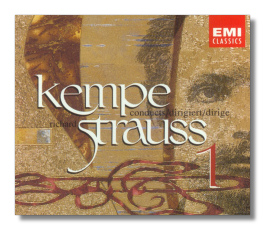
The Internet's Premier Classical Music Source
Related Links
-
Find CDs & Downloads
Amazon - UK - Germany - Canada - France - Japan
ArkivMusic - CD Universe
Find DVDs & Blu-ray
Amazon - UK - Germany - Canada - France - Japan
ArkivMusic-Video Universe
Find Scores & Sheet Music
Sheet Music Plus -
Search Amazon
Recommended Links
Site News
Richard Strauss
Annotated Discography

Parergon zur Sinfonia Domestica, Op. 73
EMI CMS764342-2
Peter Rosel, piano. Rudolf Kempe/Dresden State Orchestra (1976)
This one-movement Konzertstuck for piano (left hand) and orchestra shows greater musical quality than its successor, the Panathenaenzug, possibly because Strauss this time found inspiration beyond the commission itself: the recovery of his son Franz (Strauss and his wife gave him the pet name Bubi) from serious illness. Strauss took three bars from the Sinfonia Domestica (the child's theme) and a martial variant. Musically, the piece builds up from the contrast of the keys F and f# (health and illness, respectively), with the note C# jabbing dissonantly throughout, in much the same way as Tod und Verklärung. The narrative runs as follows: the child is ill, plunges into a refreshing dream of childhood, fights for his health, and fully recovers, to jubilant sounds from the orchestra and soloist.
Kempe's is one of the rare recordings. It's one of the best, but unfortunately it's not very good. Rosel's left hand hasn't the power to command attention. He accompanies the orchestra: he goes along with events rather than precipitates them. Kempe seems merely to run through the work. He drops one opportunity after another to ignite at least an effective showpiece. At the beginning, the repeated c#'s, which should cut to the quick, simply sound. They lose almost all their dramatic force. Kempe also makes little of the key conflicts running throughout.
Finally, Kempe also uses Wittgenstein's interpolations just before the "dream of childhood" section for the winds. This is a mistake. There's nothing wrong with the interpolations per se (they may even have been blessed by Strauss). However, they destroy the transition by solo bassoon from the music of struggle and exhaustion to the dream music by interposing a small cadenza for the pianist. Finally, Kempe treats the climactic theme of the entire work (at the end, four horns sing it out) as subsidiary material, when it should function like the horn call in Don Juan. Admittedly, the Parergon is minor Strauss, but it's not this minor.
Copyright © 1994-2008 by Steve Schwartz & Classical Net. All Rights Reserved.













